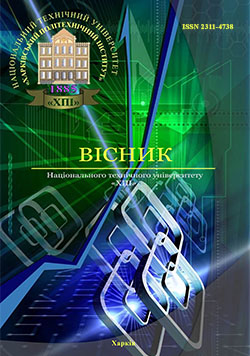COGNITIVE MODELING AS A METHOD OF QUALITATIVE ANALYSIS OF IT PROJECTS
DOI:
https://doi.org/10.20998/2413-3000.2016.1174.17Keywords:
risk, risk management, cognitive model, qualitative analysis, ranking, IT projectAbstract
The example project implementing automated CRM-system demonstrated the possibility and features of cognitive modeling in the qualitative analysis of project risks to determine their additional features. Proposed construction of cognitive models of project risks in information technology within the qualitative risk analysis, additional assessments as a method of ranking risk to characterize the relationship between them. The proposed cognitive model reflecting the relationship between the risk of IT project to assess the negative and the positive impact of certain risks for the remaining risks of project implementation of the automated CRM-system. The ability to influence the risk of a fact of other project risks can increase the priority of risk with low impact on results due to its relationship with other project risks.References
Maksimov V. I., & Nikonov O. I. (2004). Modelirovanie riska i riskovyih situatsiy: uchebnoe posobie [Modelling risk and risk situations: Textbook]. Ekaterinburg: GOU VPO UGTU – UPI, 82 [in Russian].
Lipaev V. V. (2005). Analiz i sokraschenie riskov proektov slozhnyih programmnyih sredstv [Analysis and reduction of risks of complex software projects]. Moscow: Sinteg, 208 [in Russian].
Kulikova E. E. (2008). Upravlenie riskami. Innovatsionnyiy aspekt [Risk management. The innovative aspect]. Moscow: Berator-pablishing., 224 [in Russian].
Guide to the Software Engineering Body of Knowledge (2004). Washington IEEE, 324
DeMarko T., & Lister T. (2005). Valsiruya s medvedyami: upravlenie riskami v proektah po razrabotke programmnogo obespecheniya [Waltzing with Bears: Managing Risk on Software Projects]. Moscow: Kompanija p.m. Office, 190 [in Russian].
Veres O. M., Katrenko A. V., Rishnyak I. V., & Chaplyha V. M. (2003). Upravlinnya ryzykamy v proektniy diyal'nosti [Risk management in project activities]. Visnyk Natsional'noho universytetu "L'vivs'ka politekhnika". Informatsiyni systemy ta merezhi - Bulletin of the National University "Lviv Polytechnic. Information systems and networks, 489, 38-49 [in Ukrainian].
Adamova N. (n.d.) Prynyatye proektnыkh reshenyy cherez upravlenye ryskamy [The adoption of project decisions through risk management]. Retrieved from http://www.iteam.ru/publications/project/section_38/article_1430 [in Russian].
Skopenko N. S., Yevseyeva I. V., & Moskalenko V. O. (2013). Upravlinnya ryzykamy v proektnomu menedzhmenti [Risk management in project management]. Naukovo-praktychnyy zhurnal «Investytsiyi: praktyka ta dosvid» - Scientific journal «Investments: Practice and Experience», 24, 41-44 [in Ukrainian].
Maksymov V. Y., Kornoushenko E.K., & Kachaev S.V. (1999). Kognitivnye tekhnolohyy dlya podderzhky prynyatyya upravlencheskykh reshenyy [Cognitive technologies for support of management decisions]. Tekhnolohyy ynformatsyonnoho obshchestva 98 - The Information Society Technologies 98. Moscow: YPU RAN [in Russian].
Danchenko E. B. (2013). Kohnytyvnoe modelyrovanye ryskov proekta [Cognitive modeling of project risks]. Proceedings of the 10th International Conference “Project management in development of society”. Subject: Management of programs and projects under the global financial crisis. Kiev: KNUBA [in Ukrainian].
Kuz'mins'ka Yu. (2015). Kohnityvna model' vzayemovplyviv ryzykiv proektiv v sferi pislyadyplomnoyi osvity [Cognitive model of interrelations of project risks in Postgraduate Education]. Proceedings of the 12th International Conference “Project management in development of society”. Subject: Competency management of development projects in unstable environment. –Kiev: KNUBA, 296 [in Ukrainian].
Koshkyn K. V., Makeev S. A., & Fomenko H. B. (2011). Kognitivnye modeli upravlenija zhilishhno-kommunal'nym hozjajstvom kak aktivnoj sistemoj [Cognitive models of housing and communal services management as an active system]. Upravlinnya rozvytkom skladnykh system - Management of Development of Complex Systems, 5, 17–19. [in Russian].
Onyshchenko I. I. (2014). Iyerarkhichna struktura ryzykiv IT – proektu [The hierarchical structure of risks of IT project]. Actual problems of modern scientific thought: Proceedings of the scientific and practical conference for young scientists (Kyiv, 14 November 2014,. 489. Kiev: Universytet ekonomiky ta prava «KROK» [in Ukrainian]
Onyshchenko I. I. (2014). Analiz ryzykiv v protsesi upravlinnya IT-proektamy [Risk analysis in the management of IT projects. Visnyk Natsional'noho tekhnichnoho universytetu «KhPI». Zbirnyk naukovykh prats'. Seriya: Stratehichne upravlinnya, upravlinnya portfelyamy, prohramamy ta proektamy - Bulletin of NTU "KhPI". Series: Strategic management, portfolio, program and project management, 3(1046). 140 [in Ukrainian].
Downloads
Published
Issue
Section
License
Copyright (c) 2016 Інна Ігорівна ОНИЩЕНКО

This work is licensed under a Creative Commons Attribution-NonCommercial-ShareAlike 4.0 International License.
Our journal abides by the Creative Commons copyright rights and permissions for open access journals.
Authors who publish with this journal agree to the following terms:
Authors hold the copyright without restrictions and grant the journal right of first publication with the work simultaneously licensed under a Creative Commons Attribution-NonCommercial-ShareAlike 4.0 International License (CC BY-NC-SA 4.0) that allows others to share the work with an acknowledgement of the work's authorship and initial publication in this journal.
Authors are able to enter into separate, additional contractual arrangements for the non-commercial and non-exclusive distribution of the journal's published version of the work (e.g., post it to an institutional repository or publish it in a book), with an acknowledgement of its initial publication in this journal.
Authors are permitted and encouraged to post their published work online (e.g., in institutional repositories or on their website) as it can lead to productive exchanges, as well as earlier and greater citation of published work.

